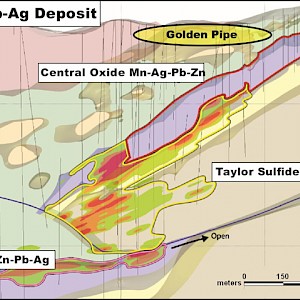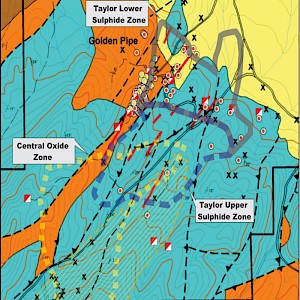Projects
Medicine Springs Project
Geological Model for Medicine Springs Project
There are two geological models are applicable to the Property.
- Near Surface Vein - High-angle, structurally controlled silver and base metal mineralization hosted by and associated with jasperoids, breccia, and mineralized replacement of the Permian and Triassic carbonate units. It was these near surface veins that were exploited by historic workings on the licence area.
- Carbonate Replacement Deposit - Historic drilling documents a replacement-style mineralization developed within receptive carbonate beds. This combination of structural and stratigraphic control is typical for many precious metal deposits in Nevada including the carbonate replacement type mineralization.

The focus for the Northern Lights exploration plan for the Medicine Springs Project is the identification of high grade carbonate replacement mineralization below the oxide zone.
In comparison to other notable carbonate replacement deposits, the Hermosa/Taylor zinc/lead/silver deposit owned by South32 is considered the best analogy for the target for the Medicine Springs Project. South32 acquired the Hermosa/Taylor deposit in its acquisition of Arizona Mining Inc. in August 2018 at a total valuation of $1.9 billion. At the time of the acquisition Hermosa/Taylor contained a total measured and indicated resource of 101 million tonnes at an average grade of 10.4% Zn equivalent.
In 2010, Arizona Mining Inc. was called Wildcat Silver, a junior explorer with a market capitalization of approximately $60 million. At that time the Hermosa Project was focused on the silver and manganese in the oxide zone above the current Taylor deposit. Following the identification of high grade zinc carbonates the focus for the company changed to zinc and the name was changed to Arizona Mining in June 2015.
In June 2018, South32 announced an all cash offer to acquire 100% of the issued equity of Arizona Mining Inc. The cash offer at $6.20 per share valued Arizona Mining Inc. at $1.9 billion. The acquisition by South32 was completed in August 2018 and Arizona Mining was delisted from the TSX.
The characteristics of Medicine Springs compared to those of the Hermosa/Taylor deposit are compelling.
The Hermosa/Taylor deposit hosts four stratigraphically controlled orebodies, including the Central Oxide, Upper Taylor and Taylor Deeps Sulphide zones. The upper Central Oxide is a manto-style, manganese-silver deposit hosted by Jurassic rhyolitic breccias and developed along the upper contact of a down-faulted block of Permian age Concha Formation carbonates. The sulfide mineralization is associated with calc-silicate alteration that is most probably related to Tertiary magmatism, evidenced by the presence of dykes and sills observed in the Permian age Epitaph Formation.
Listed geological and geochemical similarities between Taylor and the Medicine Springs Property including the following features:
- Extremely deep oxidation more than 150 meters. At Taylor the oxidation is primarily due to the weathering process of a high sulfide system while at Medicine Springs, the presence of sulfides has rarely been encountered due to the very shallow nature of the drilling.
- At Taylor, the oxide/sulfide mineralization is selectively hosted by three lower Permian age carbonate formations while at Medicine Springs, the total lower Permian and Upper Mississippian carbonates stratigraphy has yet to be explored.
- At both properties, an early stage of stratiform replacement mineralization is cut by a later stage of high grade veins and breccias.
- Oxidized minerals dominated by smithsonite & cerrusite.
- Intense sericite-silica-carbonate alteration.
- The mineralized footprint at Taylor is of similar size as the surface alteration, geochemical and geophysical footprint at Medicine Springs.
- Pathfinder geochemical signature and alteration of the mineralization are very similar (As, Sb, Ba, Ag, Hg, Mn).
The geologic comparison of the Medicine Springs Property to the Taylor deposit is preliminary and entirely speculative and can only be tested by extensive phased exploration studies.
(See “Geological Report and Summary of Field Examination, Medicine Springs Property, Elko County, Nevada dated January 15, 2018”, filed on SEDAR for more information.)


